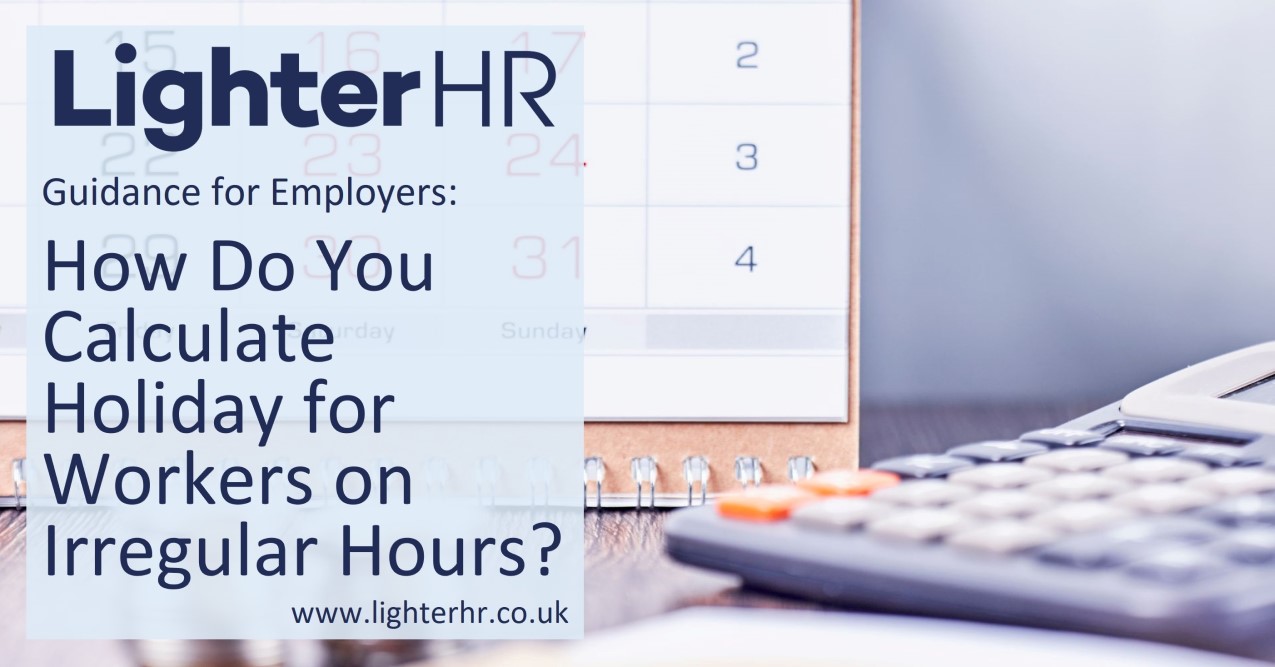Working out holiday entitlement may seem like an easy task and, if you have only full-time, permanent employees it is. However, what about calculating holidays for people on zero-hour contracts, those who work irregular hours or those who work only in term-time?
Historically, there was a recognised calculation that could be used (known as the “12.07% Method”). However, a recent case (Harpur Trust v Brazel) has stated this approach to be invalid in some circumstances.
In this post, we’ll explore issues around calculating holidays for workers on irregular hours.
Time to read our post: 5 minutes
The questions answered in this post are:
- Who Is Entitled to Holiday and How Much Holiday Do They Get?
- What’s the 12.07% Method When Calculating Worker Holiday?
- For Calculating Holiday for Workers, What Has the ‘Harpur Trust v Brazel’ Case Changed?
- How Do I Work Out a Worker’s Holiday?
- When Reviewing My Existing Contracts, What Should I Look Out For?
- When Should I Use the Harpur Trust Holiday Calculation?
- This Is Very Complicated, Is There Any Hope for a Return to the Old Calculation?
1. Who Is Entitled to Holiday and How Much Holiday Do They Get?
Holiday pay is a statutory right as set out by the UK Government. It entitles all workers to 5.6 weeks (28 days per year) paid holiday a year.
A “Worker” is different to an “Employee” so it’s important to remember that this entitlement does not only apply to your PAYE employees. The term “Workers” includes agency workers, workers with irregular hours and workers on a zero-hour contract.
Employers can include bank holidays as part of statutory annual leave. To clarify, you can allocate employees 20 days of holiday and then use the 8 public holidays to complete the rest of the statutory holiday entitlement for workers.
You pro-rate this amount for part-time workers. For example, if your employee works 3 days per week, your employee should receive 16.8 days leave a year (60% of 28 days).
An employer can decide to give enhanced leave to their employees to increase their benefits programme.
2. What’s the 12.07% Method When Calculating Worker Holiday?
Up until the Harpur Trust case, many organisations used the 12.07% for calculating holiday or workers who worked irregular hours.
This approach saw workers earn 12.07% holiday for each hour they worked.
So, if an individual worked for 60 minutes, and where holiday entitlement was statutory entitlement, the worker was awarded 7.2 minutes of holiday.
3. For Calculating Holiday for Workers, What Has the ‘Harpur Trust v Brazel’ Case Changed?
In 2021, a case was brought to an Employment Tribunal (Brazel v Harpur Trust). The case saw an employee of a school take their employer to court.
Ms Brazel was on a zero-hours, part-year contract, however, the contract remained in force throughout the entire year. She performed work on a regular basis and was only paid for the hours that she worked.
The school used the 12.07% method to calculate her holiday entitlement and pay. Ms Brazel claimed that this breached the requirements of the Working Time Regulations. She subsequently bought a claim for unlawful deduction of wages.
What did the Employment Tribunal say?
The original Employment Tribunal dismissed her claim stating that the method the school had used was compliant.
There was then an appeal to the Employment Appeal Tribunal and then a counter-appeal to the Court of Appeal. It was the Supreme Court that issued the final judgement.
The Supreme Court ruled in favour of Ms Brazel. It stated that, where a contract is in force for an entire leave year, regardless of how many weeks in which an individual performs work, they are entitled to 5.6 weeks of paid holiday.
The key thing to note is that the ruling only applies where contracts are permanent and continue to be in operation even when an individual is not undertaking work for an organisation.
In a case where a contract is permanent, the individual is entitled to 5.6 weeks’ holiday. The question then arises as to what constitutes “1 week” when an individual does not work a regular pattern.
To calculate what constitutes as a week, the employer must look at the average number of hours worked in the last 52 weeks in which work was performed.
So, it isn’t a case of just looking at the last 52 weeks and averaging hours worked in those. You need to find the last 52 weeks in which the individual performed work, and this is then the number of hours that will constitute one week of leave.
4. How Do I Work Out a Worker’s Holiday?
For employees on a full or part time contract, it’s a very easy and simple calculation.
- Holiday entitlement / 12 (months in a year) = days of annual leave accrued per month (we always recommend rounding this up to the nearest half day).
- Multiply days of annual leave accrued by the number of months worked.
For example:
- 28 / 12 = 2.333333 (round up to 2.5)
- 2.5 x 4 (months)
- 10 days
This calculation will most frequently be used when working out holiday entitlement for a joiner or leaver.
For employees who are part year workers i.e. a term-time employee or who works some weeks but not all, the method of working this out will be different.
To work out holiday for part-year workers, you will need to work out average hours worked in the last 52 weeks in which work was performed.
Employers need to exclude any weeks where no work was performed and therefore nil pay was earned (non-working weeks). They then need to keep going backwards in time until they have 52 weeks of data.
For example, to work this out using the calendar week method: 45 weeks of paid salary at £450, 7 weeks of £0 salary, extend period of weeks from 52 to 59.
5. When Reviewing My Existing Contracts, What Should I Look Out For?
It is important to remember that this new ruling only applies where the contract remains in force even when someone is not undertaking work with you.
For many people reading this post, the type of contract they will be thinking about are zero-hours contracts.
Take a look at your contract and see if there is any wording in there along the lines of “no contract shall exist between the Company and you in the periods between agreed periods of work”.
If there are, then this new ruling does not apply to you. You can continue to use the 12.07% method for calculating holiday accrual.
If you are operating contracts with irregular work patterns that are permanent and continue to be in force even when an individual is not working for you, then it’s likely you have not been calculating holiday correctly.
You should seek guidance from your payroll provider in relation to what your next step should be.
6. When Should I Use the Harpur Trust Holiday Calculation?
Below is a table with different scenarios that should hopefully make it easier to identify when you should use the 12.07% method or the new way of working:
| Scenario | 12.07% Method | Harpur Trust Method |
| My employee works 15 hours per week across 2 days, 38 weeks per year | Yes | |
| My employee works on a zero-hours contract with a statement in the contract stating “no contract shall exist between the company and you in the periods between agreed periods of work” (or something similar) | Yes | |
| My employee works on a zero-hours contract in the hospitality sector without a statement in the contract stating “no contract shall exist between the company and you in the periods between agreed periods of work” (or something similar) | Yes |
7. This Is Very Complicated, Is There Any Hope for a Return to the Old Calculation?
There actually is!
As the ruling has come from the Supreme Court, case law is currently settled on this point. The only way for this to be changed is through a change in legislation.
In January 2023, the government launched a consultation snappily entitled “Calculating holiday entitlement for part-year and irregular hours workers”.
The consultation was open until 9th March 2023 and we wait to see whether the law will change.
Want to Know More?
We appreciate this post is both complicated and nuanced, however, it is important that an employees holiday is calculated correctly to avoid
If you’d like any guidance on calculating holiday for workers with irregular hours, give us a call on 0203 319 1649 or contact us using the contact form.
Get In Touch

Speak with an HR Expert
Chat through your HR requirements with one of our expert consultants to understand the actions you can take and how we can help.


